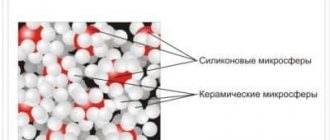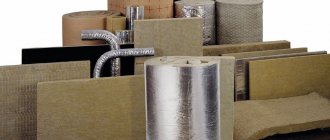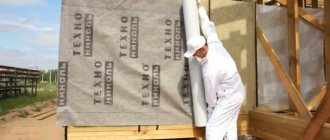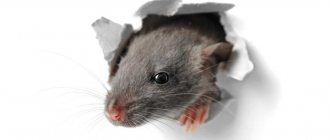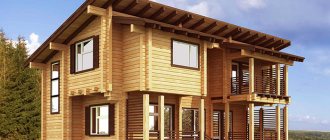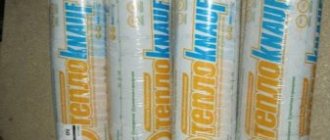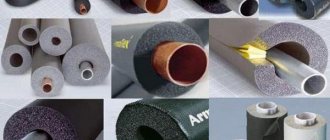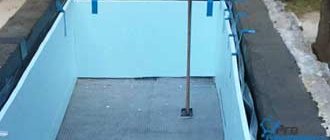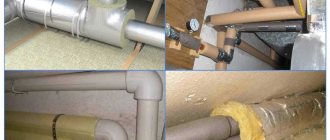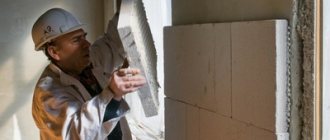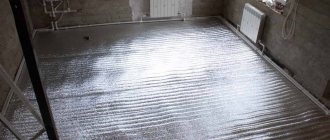Wall insulation with roll insulation is most often used in cases where the wall area is significant and there are long straight spans. In this case, it is possible to achieve significant savings in material costs and performance compared to insulation in the form of slabs or mats. A variety of insulating materials are supplied in rolls, from mineral wool to pressed cork. Each of them has its own advantages in specific conditions. Installation of roll insulation is not a complicated operation and does not require highly qualified workers or expensive equipment.
Technology of wall insulation with mineral wool
- Preparing walls for laying insulation depends on the material from which they are built. Wooden walls must be impregnated with an antiseptic to avoid damage to the log house by microorganisms. Areas damaged by rot, fungus, and mold must be thoroughly cleaned and soaked in appropriate solutions - after installing the insulation, access to them will be impossible. It is enough to free brick and foam concrete walls from peeling plaster and paint. If the walls are wet, they must be thoroughly dried. Window trims and slopes must be dismantled, and fastening and decorative elements that can damage the vapor barrier and insulation layer must be removed from the walls.
- A layer of vapor-permeable membrane is placed under the mineral insulation. The film is positioned so that the vapor-permeable side faces the wall of the house, and the smooth side faces the insulation. A vapor-permeable membrane is necessary to ensure the removal of water vapor from the walls of the house through the insulation. It is allowed to lay mineral insulation on smooth walls without first laying a membrane film.
- Wooden guide rails or a profile for attaching drywall are attached on top of the vapor-permeable film. They are attached to the wall with self-tapping screws or using a dowel-nail mounting pair. The distance between the slats is chosen so that it is 1-2 centimeters less than the width of the insulation. The thickness of the slats should be equal to the thickness of the insulation. Attaching the slats starts from the corner of the house. When attaching the slats, use a level. If the wall is uneven, you can use perforated plasterboard hangers to secure the frame. If you use insulation in the form of mats, you can additionally attach a horizontal strip along the lower border of the wall, on which the lower insulation mat will be installed.
- Thermal insulating mats or rolled material are placed in the space between the guide slats, while laying the mats begins from the bottom, and the rolled materials from the top, fixing the insulation to the wall either directly between the slats, or using several dowels with a wide head. The slab material is attached to brick or block walls with a special glue that ensures a tight fit of the insulation. There should be no gaps between the insulation and the guides. First, solid pieces of insulation are fixed, then the remaining areas around window and door openings are filled.
- Another layer of film is placed on top of the mineral insulation - wind protection and waterproofing. The film must also be vapor-permeable so that moisture can be easily removed from the insulation layer to the outside. The film is fastened with staples to the slats without tension, after which the entire layer of insulation and vapor barrier is additionally secured to the wall using dowels with a wide head; the attachment points can be glued with metallized tape for better waterproofing.
- An important stage in wall insulation is the installation of a ventilated façade. The ventilation gap should be at least 5-6 cm; for this, additional counter-battens are placed on top of the guides or profiles are attached on which the ventilated facade is mounted: siding, block house or other finishing materials.
- When insulating the walls from the outside, their thickness increases, so you will have to install new window slopes, window sills, as well as trim and finishing elements. It is better to purchase them immediately when purchasing a ventilated facade.
Insulating walls outside with mineral wool is one of the most popular methods of thermal insulation of buildings. Its popularity is due to the low thermal conductivity of mineral wool, due to which most of the heat remains inside the building, as well as the environmental friendliness of the material and its ability to remove moisture from inside the house. In addition, mineral wool is an excellent sound insulator.
Other materials are also used to insulate walls, for example, polystyrene foam or extruded polystyrene. These methods are used for plaster finishing, since slab insulation is an excellent basis for plaster. We also have an article that describes the advantages and disadvantages of all types of insulation for walls from the inside.
Ceiling thermal insulation methods
There are several methods for thermal insulation of the ceiling of a house:
• external method (with or without replacement of the roof covering)
• insulation from the inside.
An option for external insulation is created from the attic, under-roof space and attic of the house.
Naturally, this is a labor-intensive and expensive insulation method.
If you want to insulate the ceiling from the inside, then it is better to give preference to mineral insulation, made in the form of slabs or rolls.
A strong alliance with a plasterboard suspended ceiling will create a reliable barrier to heat leaking out. Let us tell you a secret, if there is a possibility of external insulation, then this option is more preferable.
2 Rolled thermal insulation based on mineral wool
The quality of this category of insulation is regulated in accordance with the requirements of GOST RF “52953-2008”. This quality standard allows the following thermal insulation material to be classified as mineral wool insulation:
- Basalt wool is a material produced by melting rocks and then forming microscopic fibers from them, connecting them into a solid carpet;
- Slag wool is a material made from waste from the metallurgical industry. As a rule, it costs much less than basalt wool;
- Glass wool is a morally obsolete material, but still quite often used due to its low price. Produced by melting cullet.
Rolled basalt wool has a characteristic yellow tint
Rolled insulation based on mineral wool, due to its elasticity and flexibility, is an extremely versatile material that can be successfully used for thermal insulation of walls, floors, attics, and other flat surfaces, as well as for thermal insulation of pipes.
To insulate pipes, special cylinders are made from mineral wool, which are simply placed on the surface of the pipes without any additional processing. This is an excellent analogue to polystyrene foam and extruded polystyrene foam.
2.1 Mineral wool production
Let's look at the technology for making mineral wool using basalt insulation as an example. Basalt rocks, the chemical composition of which meets GOST requirements, can be melted in two ways - hot and cold.
The hot method involves heating basalt rocks in blast furnaces, the cold method involves exposure to electromagnetic radiation (like a conventional microwave).
The molten rock is fed into a centrifuge, which is equipped with constantly cooling carbide disks. Under pressure, molten basalt is fed into a centrifuge and falls onto rotating disks, where individual basalt fibers are formed from the melt through the process of cutting cooling and pressure drop.
The resulting fibers are immediately removed from the drum by a special functional element and supplied via a conveyor to a laying machine, which forms a carpet of basalt wool of the required thickness.
After laying the carpet, the fibers are impregnated with various impurities, which are necessary to give the final product the required characteristics - hydrophobicity, fire resistance, density and elasticity.
Slag material, as a rule, has a darkish tint
2.2 Advantages and disadvantages
Among all the thermal insulation materials on the market in the middle price category, it is mineral wool that has the lowest thermal conductivity. Although the leaders in general are polystyrene foam and mineral wool.
An important factor is that the thermal insulation properties of mineral wool do not depend in any way on any external conditions - this material does not expand under the influence of moisture, is not subject to thermal expansion, and microorganisms and rodents do not grow in mineral wool.
Rolled mineral wool insulation is produced with a wide variety of performance characteristics - you can choose either low-density mineral wool for insulating pipes and other uneven products, or dense material for thermal insulation of surfaces that experience external loads - the floor or attic floor.
An important advantage of mineral wool is its fire resistance. This material can withstand temperatures up to 700 degrees; it does not ignite even under direct exposure to fire. It is also worth noting good noise-reducing properties - by insulating walls and floors with rolled mineral wool, you will solve not only the issue of insulation, but also sound insulation of the house.
The only drawback of mineral wool is its high vapor conductivity, due to which the installation of a special vapor barrier film is required when installing this insulation.
Thermal insulation of the pipeline using rolled glass wool
Rolled mineral wool insulation can be used for the following purposes:
- Insulation of roofs, floors, walls, and any flat surfaces;
- Thermal insulation of pipes and pipelines;
- Thermal insulation of industrial equipment;
- Insulation element inside sandwich panels (here the best thermal insulation is Hitrock);
- Internal insulation in false walls and when laying hollow walls;
- External insulation of house walls followed by plastering.
How to understand what exactly needs to be insulated
To reliably assess the need to insulate a house and identify problem areas, you should invite an auditor to inspect the building using a thermal imager. Based on the research results, engineers will make a “diagnosis” and make recommendations for improving problem areas. If the house was built more than 5 years ago, then with almost 100% probability it will require insulation.
If we talk about those who are just planning construction, then it is worth saying that not all wall materials allow the construction of single-layer structures. Therefore, very often developers choose the option of making load-bearing structures relatively thin, but then immediately insulating them.
That is, instead of 40 cm of aerated concrete walls, 30 cm of blocks + 10 cm of insulation, for example mineral wool, are erected. This “pie” provides much better performance in all criteria, although the overall thickness of the structure is the same. There are several types of mineral wool offered on the construction market. Let's look at the main thermal insulation options.
Types of materials in rolls
There are two groups of insulation materials, characterized by flexibility, low density and rigidity:
- Based on expanded polystyrene, polyethylene. Such materials are characterized by a closed-porous structure, which is achieved by foaming the raw materials. As a result, most of the volume is a gaseous medium. By foaming polyethylene, a flexible coating of small thickness is obtained. Roll insulation of this type is characterized by low thermal conductivity, wear resistance, and lasts a long time.
- Mineral wool is presented in varieties: glass and slag wool, basalt or stone wool. These are natural insulating coatings characterized by low thermal conductivity. Disadvantages include low strength, tendency to sag during operation, and hygroscopicity. The last of the properties is the reason for the short service life of the coating. This insulation is suitable for walls, floors, ceilings, attics, basements, and roofs. If you provide protection from moisture in areas with high loads, you can avoid deformation of the coating.
Characteristics
Thermal insulation material in rolls, produced under various brands, is characterized by general characteristics.
Environmental friendliness
The insulation meets regulatory environmental safety requirements.
As a rule, salts of heavy metals, alkalis, acids, oxides, phenols or toxic organic compounds that are inactive at room temperature are present in minimal quantities.
Due to its low chemical activity, thermal insulation practically does not interact with aggressive environments, and therefore, for example, is not afraid of exposure to solvents.
Biological resistance and fire safety
The material has a high level of biological resistance. As a result, there are no rodents, fungus, or mold in it. It is of no interest to insects and animals as food. Depending on the composition and other characteristics, the insulation can withstand high temperatures.
Air and vapor permeability
If insulation is used to insulate floors or walls, air permeability is an important indicator.
When using rolled materials, you do not have to worry about excessive dampness in the room, condensation and other negative phenomena, provided that the installation is done correctly.
Installation and operational efficiency
Installation of polyurethane foam is quick and easy.
Comparison of the characteristics of insulation materials should be carried out taking into account installation, because this is also important. It is easiest to work with liquid thermal insulation, such as polyurethane foam and penoizol, but this requires special equipment
It is also not difficult to lay ecowool (cellulose) on horizontal surfaces, for example, when insulating a floor or attic floor. To spray ecowool on walls using the wet method, special devices are also needed.
Polystyrene foam is laid both over the sheathing and directly onto the work surface. In principle, this also applies to stone wool slabs. Moreover, slab insulation can be laid on both vertical and horizontal surfaces (including under screed). Soft glass wool in rolls is laid only on the sheathing.
During operation, the thermal insulation layer may undergo some undesirable changes:
- absorb moisture;
- shrink;
- become a home for mice;
- collapse from exposure to IR rays, water, solvents, etc.
In addition to all of the above, the fire safety of thermal insulation is important. Comparison of insulation materials, flammability group table:
| Name of material | Flammability group |
| Minvata | NG (off) |
| Styrofoam | G1-G4 (highly flammable) |
| PPU | G2 (moderately flammable) |
| Penoizol | G1 (low-flammability) |
| Ecowool | G2 (moderately flammable) |
Inter-crown heat insulator and its features
Inter-crown thin heat insulator for buildings made of timber.
A separate type of flexible insulation is designed to fill voids in the inter-crown space of log and timber houses. A distinctive feature of the material is its small width, which facilitates the installation process. The material is made from natural raw materials - batting, jute, flax.
You can use such thermal insulation in convenient narrow rolls not only during the construction of a new house, but also several months/years later.
What else to consider?
When choosing one or another type of isolon from a trusted manufacturer, it is necessary to take into account the remaining components for creating flowers or floral arrangements. For example, in one case these will be wall mounts or photo zones, in another – floor supports. You also need to take into account the type of glue when assembling individual flowers, selecting the required option. In addition, when purchasing, you need to remember: high-quality material must be safe. It cannot be taken from dubious organizations.
In order for the product to be delivered in the best possible condition, you need to ask the seller for high-quality packaging that will not break during delivery. Do not allow dirt or significant mechanical damage to enter. Despite the fact that the material often arrives without damage, the unscrupulous attitude of individual postal service workers cannot be discounted.
You should not look for creative products in construction stores or try to save on purchases by purchasing insulation (foam backing). The technical characteristics and properties of these materials will be different, as will the scope of application. It will not be possible to work with material that is not suitable for this. In addition, such savings can completely discourage handicrafts.
To learn how to make flowers from isolon, see the following video.
Roll Size Chart
For comparison, we take insulation whose thickness does not exceed 50 mm. This is due to the fact that more massive rolled thermal insulation materials roll up much worse. The review involves fiber coatings. Manufacturers of insulation in rolls:
| Material grade | Width, mm | Length, mm |
| Ursa M-11 | 1200 | The manufacturer offers two options: 7000 and 9000 |
| Heat Knauf Dacha | 1220 | 7380 |
| Isover Classic | 1220 | 8200 |
| Isover Sauna | 1220 | 12500 |
To compare coatings by cost and determine the most suitable option, take into account the number of strips in the package.
Features of three-layer wall construction
This type of wall construction is similar to a sandwich. Two walls, and between them a heat-insulating material. Walls made of foam block and brick are often insulated in this way.
Option for wall insulation using sandwich technology.
This insulation option is used in almost all new buildings. Rough brick wall, insulation and facing layer.
Extruded polystyrene foam boards are best suited for this type of insulation. Despite the good thermal insulation properties, this type of wall insulation also has a drawback. It is not as durable as other insulation options.
Advantages and disadvantages
*
The main advantages of rolled material are:
- Versatility. Suitable for thermal insulation of any surfaces. For complex spatial shapes, including curved ones, you can cut out a suitable piece.
- Minimum requirements for surface preparation before installation.
- Benefits in terms of material price and work productivity when insulating large areas of walls, especially straight sections.
Roll materials have disadvantages.
- High labor intensity when laying in frequent lathing; additional time is required for cutting.
- Low rigidity does not allow them to be used where it is necessary to withstand significant loads.
In general, the advantages compensate for the disadvantages, which explains the high popularity of roll materials among consumers.
The materials are harmless to health provided they are used correctly and fire safety regulations are observed.
Video description
About mineral wool in the following video:
There are several varieties of this fibrous material, differing in the method of production and properties:
- Stone wool
. The starting materials are rocks (basalite, diarite, porphyrite), but more often basalt. In construction, a second name has taken root - basalt wool, although this particular variety is more often used for thermal insulation of industrial equipment and pipelines. Stone wool is a durable, non-flammable and environmentally friendly material with a high ability to retain heat. The small shrinkage of this slab material during operation prevents the formation of cold bridges. - Glass wool
. It is made from molten glass, produced in slabs and rolls, and has characteristics similar to mineral wool. Glass wool has increased strength, elasticity and vibration resistance. However, glass wool fibers are fragile, and debris poses a health hazard. Working with the material requires the use of a respirator and special clothing, as well as installation using special technology. Glass wool is cheaper than mineral wool, but its service life is shorter.
Glass wool requires careful handling Source pinterest.fr
Slag wool. The raw material is molten blast furnace slag. This type of filler is similar in properties to glass wool; It is recommended to use it only for dry rooms. The main advantage of slag wool is its low cost.
Walls, ceilings and roofs are insulated with cotton wool; The thickness of the layer in a country house for year-round use should be 200-250 mm. The peculiarity of cotton wool is that its hygroscopicity is neutralized by the use of vapor and waterproofing membranes. The density and thickness of the material affects not only the cost, weight and load resistance, but also the way it is used:
- Rolled fabric
(often laminated, with foil coating). Effective heat retaining material. Used for thermal insulation of horizontal surfaces, has a density of 35 kg/m3. - Plates
. Material with a density of 75 kg/m3 is used to insulate the floor, ceiling and interior partitions, and a density of 125 kg/m3 is used to insulate the facade. More rigid slabs (200 kg/m3) are used for interfloor ceilings, roofing and screed floors.
Element of the roofing pie - mineral wool with foil coating Source pinterest.cl
Ecowool
Cellulose wool (known to the general public as ecowool) is an example of an environmentally friendly product. It consists of 80% of newspaper waste paper and waste from the cardboard and paper industry, and 20% of additives that perform a flame-extinguishing function (boric acid and sodium tetraborate). In appearance it is a loose material of various shades of gray.
Ecowool has proven itself well as sound and heat insulation; it insulates all parts of the frame structure. The disadvantages of ecowool are its high cost and the use of special equipment during installation. Insulation of a frame structure with ecowool is carried out in one of four ways:
- Dry backfill
. Manual labor-intensive method, limited in application. Suitable for insulation and soundproofing of small-area interfloor ceilings, ground floor floors, and attic floors. - Dry blowing
. The most preferred (fast and high-quality) method, suitable for insulating any cavities. It is carried out using blow molding equipment.
Choice of insulation: rolls or slabs
The main difference between roll and slab insulation is in their size and packaging method and, accordingly, in the ease of installation and scope of application.
- Rolled insulation materials are primarily used in the installation of pitched roofs, attic floors and floors along joists, and sometimes for interior partitions. They are lighter and have a longer package length. Therefore, it is more convenient to install them for these structures. It is easier to raise them to a certain height, after which you need to cut the required width in the package, place the roll between the joists and roll it out.
- Board insulation is heavier and stronger. Lightweight products have fairly high elasticity. Rigid slabs are mainly used for insulating building facades, in ceilings, and when installing a floating floor. Lighter ones - in frame structures, as well as in pitched roofs, and in floors along joists. The density range of slab insulation materials is 13-190 kg/m3. Working with them is more labor-intensive. The main thing is to look at the area of its application before purchasing a material, to clarify where use is recommended and possible.
Tips and tricks for using wall insulation
Before starting thermal insulation work, the homeowner must understand which insulation is best for the walls of his house. In fact, this issue should be resolved at the design stage. That is, a thermal calculation must be performed, on the basis of which the thickness of the insulation will become clear. After this, you can select the material. If you are insulating a house yourself, you will have to do this calculation yourself, but it is quite complicated and therefore you can involve third-party specialists or use an online calculator. Which can be found on the websites of specialized companies involved in thermal insulation.
Why is it important to insulate your home?
In the most successful version, the building should be similar to a thermos, that is, it should retain heat in winter and prevent the summer heat from turning rooms into steam rooms. This is only possible if the structures are well insulated and hermetically sealed. Insulating a home is not cheap, but it pays for itself thanks to the comfort of living and reduced energy bills.
Every few years, requirements for the energy efficiency of buildings become more stringent. But in fact, it’s not even about standards and protecting nature. Potential developers and real homeowners just need to look at the tariffs for gas, electricity, and solid fuel. All prices have already risen and will continue to rise. These disappointing calculations are the best motivation and a good reason to “warm up”.
What types of wall insulation are there?
To choose a heat insulator for walls, you first need to understand its types and their technical characteristics.
Materials of organic origin are used for interior decoration. They are made using natural raw materials - waste from the wood processing industry or agricultural products. Additional components are plastic and cement. Each type has its own characteristics.
Arbolit
To make it, crushed sawdust, wood shavings and reed stems are used. Cement with calcium chloride and alumina is used as a binding component.
Arbolite insulation
Properties of wood concrete:
- environmental friendliness - 90% consists of organic substances;
- almost not affected by mold and mildew;
- provides good sound insulation and air exchange;
- low thermal conductivity – no more than 0.12 W/(m*K);
- easily withstands frost, fireproof.
The material lends itself well to processing. It can be sawed into pieces, screwed into it, or nails driven into it. This prevents it from crumbling or breaking.
Particle board
90% consists of crushed shavings. The remaining 10% comes from formaldehyde resins and antiseptics. The material is also impregnated with fire retardants - substances that increase its fire resistance.
Chipboard characteristics:
- homogeneous structure;
- environmental friendliness;
- resistance to temperature changes;
- humidity – within 5-10%;
- ease of installation.
Particle board
The slabs have weak edges. To prevent them from crumbling, the sheets need to be adjusted to each other with maximum density. They also cannot withstand heavy bending loads, so they can sag.
Foamed polyethylene
It has a porous structure. Consists of polyethylene and a hydrocarbon-based foaming component.
Foamed polyethylene
It features the following set of characteristics:
- provides good vapor barrier;
- almost does not absorb moisture;
- not susceptible to chemicals and rotting;
- withstands temperatures from -40 to +100 degrees;
- serves as a reliable sound insulator.
Foamed polyethylene is produced in rolls.
Fibrolite
The basis for the material is wood chips. Magnesite or cement is added to it as a binding component. Sold in slab form.
Fiberboard
The features of this insulation include:
- fire safety;
- ability to absorb noise;
- low thermal conductivity – up to 0.1 W/(m*K);
- increased resistance to aggressive chemical environments.
Suitable for insulating walls in rooms with high humidity - for a swimming pool or bathroom.
Price for fiberboard boards
Fiberboard
Honeycomb insulation
It contains hexagon-shaped cells. In appearance they resemble honeycombs. The raw materials for the material are cellulose, fiberglass or special fabrics. The honeycomb is covered with a thin layer of film on top. Epoxy or phenolic resin is used to bind the fibers. The outer side of the heat insulator is a sheet of plastic.
Insulation in the form of corrugated fabric
Distinctive properties of insulation:
- absorbs noise;
- retains heat for a long time;
- fireproof;
- strongly absorbs moisture.
Ecowool
It is based on paper and cardboard waste. If ecowool is laid with a continuous coating, there will be no seams on the surface of the walls.
Ecowool
Features of the material include:
- high noise insulation;
- health safety;
- quickly absorbs moisture;
- Retains heat for a long time.
But over time, the thermal insulation coefficient decreases because the material loses up to 20% of its initial volume.
Cork wallpaper
At the same time it can serve as insulation and finishing material. The raw material for it is the bark of the cork tree. It is first crushed and then pressed. Cork wallpaper can be left in its natural form or varnished.
Cork insulation
They differ in the following characteristics:
- environmental friendliness;
- long service life;
- fire resistance;
- excellent sound insulation.
The material also has antistatic and antimicrobial properties. Using cork wallpaper, an optimal microclimate is created in any room.
Stone wool. Advantages.
The role of the foil surface
The main feature of such insulating devices is the presence of a thin but durable foil coating. In this way, the material is protected from the negative effects of ultraviolet rays and high humidity, which is very important when equipping industrial premises, kitchens, bathrooms, baths, saunas.
Foil insulation withstands high temperatures well
Laying of foil insulation is carried out in accordance with a special technological process. A gap of 1-1.5 cm must be created between the thermal insulation and the finishing material. This is very important, since at elevated temperatures the insulation maintains a given degree by transferring it to the back wall and then returning it back to the walls, but not to the room.
In comparison with rolled materials made of slag wool, glass wool and basalt base, the foil product must be fixed to the lathing. The layers are overlapped, and their joints are carefully treated with insulation.
Instructions for installing sheathing
The lathing technology for all types of walls is standard and consists of the following operations:
- the passage of vertical and horizontal slats is marked. The dimensions of the cells in height and width should be 2-5 cm smaller so that the mats stand upright and stay inside the structure only due to the elasticity of the insulation;
- a vertical frame is attached to the wall. A beam measuring 50x100 mm must be equal to the height of the room;
- horizontal strapping slats are installed. The size of the block is 50x50 mm, the length is equal to the distance between the vertical strapping slats. Attached to a vertical stand using a metal angle. Can be attached directly to the wall;
- Vertical internal racks are installed. The pitch is equal to the width of the insulation minus 2-5 cm. The fastening is carried out either with corners to the horizontal trim, which is easier, or to the wall;
- Horizontal bars are attached between the posts. Do not forget that the distance between them should be slightly less than the size of the insulation boards.
A schematic diagram of the sheathing device is shown below.
Sheathing diagram.
- 1 - sheathing strapping bars;
- 2 - vertical bars;
- 3 - horizontal bars;
- 4 - metal corners on screws or nails;
- 5 - fasteners fixing the harness to the wall.
The process of installing the sheathing is completed by tying the windows and doors.
Preparing the walls from the inside in the apartment
The use of basalt wool for wall insulation minimizes the amount of preparatory work, since there is no need to install lathing for decorative plaster, painting and wallpapering. It is enough to attach a fiberglass reinforcing mesh to the surface of the insulation, and then apply a layer of putty over the dried glue, with the help of which a flat surface will be obtained.
Lathing is only needed for ceramic tiles and PVC panels. You can see how to arrange it correctly using the example of wooden walls. We should not forget that the walls themselves still need to be prepared. In this case, technological operations are performed in the following sequence:
- switches, sockets, lamps, various fasteners, etc. are removed from the walls;
- the old finish is removed, and, if necessary (it’s leaking in many places), the plaster is removed;
- the wall is cleaned of dust and dirt, including smoked areas and oil stains;
- small and large cracks are sealed.
There is no need to carefully level the surface - the cotton wool will hide everything.
Facade preparation
Insulating the outside of a house with basalt wool begins with preparing the facade for thermal insulation work. They are performed according to the following scheme:
- Rainwater drainage systems, doorway and window frames, lanterns, etc. are removed from the walls. As a result, the wall should be completely bare;
- the surface of the walls is cleaned of dirt and dust, deposits of masonry mortar;
- The verticality of the wall is checked. If the slope is more than 1.5 cm for every 3 m, work is carried out to level it (a layer of leveling plaster is applied);
- existing gaps, cracks and holes are sealed with repair mortar. How to properly repair cracks formed due to shrinkage of the building can be found in the work “How to prepare walls for wallpapering”;
- wooden walls are impregnated with fire retardants and antiseptics;
- facade made of brick, concrete, aerated concrete, foam blocks, etc. treated with deep penetration primer in 2 layers;
- Under the sheathing, a vapor barrier membrane (type A) is attached to the walls with the smooth side facing the insulation. For fixation, you can use the staples of a construction stapler. In order for the vapor barrier to be of high quality, the membranes must overlap each other by 15-20 cm (overlapping), the seams are taped with regular tape. Many specialists ignore this operation. But this is the case when “you can’t spoil the porridge with butter”;
Cornice under basalt wool.
Cornice connection at outer corner.
With a wide foundation, you can do without a cornice. Basalt mats are installed directly on the foundation base, previously covered with roofing felt, to prevent moisture from entering the insulation from below.
The sheathing is placed on the fixed membrane.
Popular manufacturers
There are products from various manufacturers on the market. Each brand has its own characteristics and advantages.
Knauf
The German manufacturer offers a material that does not contain formaldehyde. Knauf products are safe for people. Mineral wool does not cause allergies, but it should be installed with gloves. Microscopic fragments included in the insulation can cause skin irritation.
Knauf roll materials are not of interest to insects and rodents. In addition, they are able to protect against external noise due to their good soundproofing characteristics. They are characterized by low thermal conductivity and good air permeability. The company offers materials for protecting walls, slabs, pipes and other surfaces in dachas and country houses.
Izover
High density insulation. The French manufacturer offers products of various thicknesses: from 20 to 150 mm, which significantly expands the possible area of use of Isover insulation.
The company's catalog presents thermal insulation material with foil, which is often used for insulating pitched roofs, walls, ceilings, and installing heated floors not only in houses, but also in baths and saunas. In terms of flammability it corresponds to the first class.
High-quality professional insulation with a long service life. Has excellent soundproofing characteristics. Does not burn. When exposed to flame, it does not emit toxic substances. It does not break or crumble during installation. Pleasant to the touch.
a child of unknown gender was born in Tyumen
When insulating the walls of private houses, M-11 is most often used. When performing thermal insulation work in an industrial complex, preference is given to P-30.
Topizol
The insulation can have a thickness of 3 – 20 mm. Suitable for various climate zones, including regions with high humidity. Doesn't rot. It has good vapor permeability. When ensuring sufficient tightness of the seams, it can withstand gusts of wind.
Used to protect walls, roofs, including attics, and floors. It is lightweight, which facilitates transportation and reduces the requirements for the strength characteristics of the insulated surface. Able to maintain its performance characteristics for at least 30 years.
Installation can be done independently without special equipment.
Penofol
Multilayer foil material comes in several types. Type A provides for the presence of one foil layer. Type B has self-extinguishing polyethylene between layers of high-quality aluminum foil. Type C comes with a special adhesive base, which greatly simplifies its installation. Type A has the lowest cost and the least rigidity.
The foil thickness of Penofol is 12 - 30 microns with a base thickness of 2 - 10 mm. To insulate surfaces operating in fairly harsh conditions, material up to 40 mm thick can be used.
Eco-friendly, safe, suitable for insulating children's rooms.
Scope of application of roll insulation
Roll insulation materials are used for thermal insulation of vertical and horizontal surfaces. Foil material is indispensable for creating thermal insulation in bath rooms, as it retains heat well and has heat-reflecting properties. This material has also found wide application for thermal insulation of individual structures, joints, and in hard-to-reach places.
Let's look at the main ways to use rolled heat insulators.
Rolled thermal insulation for walls
Rolled wall insulation can be used as a heat-insulating material applied under decorative finishing, including wallpaper.
The application technology is very simple:
- self-adhesive material is glued to a wall that has been prepared in advance, leveled and cleared of debris and old finishes;
- A cement-based adhesive is applied to the heat insulator layer, its properties reminiscent of liquid plaster;
- After the adhesive has hardened, you can begin gluing the wallpaper.
The use of such material for wallpaper will significantly increase the heat-retaining properties of the walls, as well as their sound insulation.
Rolled floor insulation
It is used as a substrate for various types of decorative floor coverings. It not only has heat-insulating properties, but also gives the floor “softness”, eliminates squeaks and sounds when the floor covering shrinks and moves.
In some cases, a foil thermal insulator can be used to insulate the floor; this will increase heat retention; however, the cost of materials reinforced with foil is 30–60% more expensive.
The technology for performing floor insulation work using foamed polymer in rolls is very simple:
- the material is glued to a wooden floor or concrete screed using an adhesive composition or self-adhesive properties;
- leveled so that there are no “bubbles”;
- The floor covering is laid on top.
The advantages of such a heat insulator include ease of installation, lack of debris, durability and environmental safety. When choosing a roll insulation for the floor, it is worth remembering that the “softer” the floor covering, the denser the insulation should be.
In other words, it is better to use a polymer with maximum density under linoleum, otherwise when you walk you will “sink” into the floor covering, but under laminate or parquet you can lay a polymer with any density.
Rolled roof insulation
Suitable for thermal insulation of pitched and flat roofs. A roof insulated with such material will remain warm for several decades. You can install thermal insulation on your own, without involving highly paid specialists. The heat insulator is located between the elements of the roof rafter system, and distortions, the formation of waves and other defects are not allowed.
The technology for installing roof thermal insulation depends on the design features. The best option is when thermal insulation is calculated at the design stage. In this case, the work boils down to rolling out the rolled material and gluing it to the inner surface of the roof, laying a layer of vapor barrier material on top and installing the final finish, for example, siding, lining, etc.
Manufacturers and selection criteria
One of the leading companies producing roll insulation is the German company Knauf . A distinctive feature of the product is the absence of formaldehyde. In addition, the materials are characterized by ease of use. This company provides installation instructions for almost every roll, which will allow novice builders to do their insulation work better. Due to the composition, insects (beetles, ants) and rodents (rats) will not be able to settle in such thermal insulation.
No less famous is the French brand Isover . This company has a huge selection of roll-type insulation. Foil rolls are also available. The products of this company are used for insulating interior spaces, as well as outside buildings.
Due to its composition, it is fire-resistant; in the event of a fire or brief ignition, it does not support combustion and goes out on its own.
The most widespread in the European part of Russia is the Spanish company URSA . Its products are somewhat cheaper than the French brand, the range is in no way inferior to it, which makes the materials in demand among buyers. The company provides a very long warranty on its products; it is better to check the exact warranty figures immediately before purchasing.
Popular brands
The domestic market has no shortage of roll materials. Different manufacturers are leaders in different types.
Knauf
The German company produces excellent mineral insulation materials. They are free from formaldehyde and other harmful substances, and thanks to the specially designed fiber structure, they do not provoke allergic reactions. However, the manufacturer recommends carrying out installation work with thick gloves. They perfectly muffle noise and are impregnated from insects, rodents and mold.
Mineral wool Knauf 1220Х6148Х50
Izover
The French company launched production at local sites. Offers a wide range of rolls with thicknesses from 20 to 150 mm, allowing you to retain heat in all weather conditions. There are many foil models that can be used in rooms and buildings with high humidity.
Isover Klassik 50 mm thick
Easy to install, the material has a long service life and excellent fire protection properties.
For wall insulation, the Ursa Geo M11 model is offered.
Ursa Geo M11 for wall insulation
Topizol
Foamed roll material is available in thicknesses from 3 to 20 millimeters. Performs well in high humidity conditions. Not subject to rotting. Very light, easy to install. Foil models resist strong gusts of wind (provided they are installed correctly). Characterized by excellent vapor permeability.
Foamed polyethylene
It is a good choice for insulating walls, including loggias, attics, and attics. It has low density, which makes transportation and handling easy and convenient.
The manufacturer claims a service life of 30 years.
Penofol
The heat-insulating layer is made of foamed polyethylene. Several types of penofol are available:
Available in thicknesses from 2 to 40 millimeters, foil thickness is 30 microns. It does not emit any harmful substances and is recommended for insulating children's rooms.
Penofol V. Double-sided filming
Main types
Experts highlight the following features and types of insulation supplied in rolls.
Based on material, insulation materials are divided into several types:
Mineral and polymer roll insulation can be covered on one side with aluminum foil to reduce thermal conductivity and improve waterproofing. A thin layer of foil reflects over 95% of thermal radiation, returning heat to the insulated room. Foil not only reflects heat well, but also increases the strength of the material.
Mineral basalt wool in roll
Thermal insulation KNAUF
KNAUF insulation is suitable for floor insulation. It can be used for floor insulation in a wooden house, for thermal insulation of floors in a cottage, for insulation of a summer house. KNAUF insulation is made in accordance with GOST and is environmentally safe for both people and animals. If you need to insulate the floor in your dacha, you can buy KNAUF insulation in rolls. KNAUF dacha roll insulation is suitable for dachas, summer kitchens, sheds, and utility rooms.
Characteristics of KNAUF dacha roll insulation
The thickness of the KNAUF dacha roll insulation is 5 cm. The width of the KNAUF thermal insulation roll is just over 120 cm, and the length of the insulation roll is more than 7 meters. Taking into account the specified parameters, one roll of KNAUF dacha insulation is enough for 9 square meters of floor. KNAUF packaging usually contains 2 rolls of insulation. In order to determine the optimal thickness of the insulation, you can refer to SNiP standards or consult with floor insulation specialists or consultant managers at a building materials store. The thickness of the floor insulation is one of the essential parameters for comfortable living in a wooden house.
KNAUF floor insulation slabs
KNAUF tile insulation allows you to achieve a tight fit and get rid of cold bridges when insulating the floor and ceilings in the house.
An excellent material for insulating floors and ceilings are Heat KNAUFHouse slabs with a 3D elastic effect. The thickness of KNAUF insulation in Heat KNAUFDom slabs is 5 cm, and Heat KNAUFDom+ is 10 cm. KNAUF tile insulation allows you to achieve a tight fit and get rid of cold bridges when insulating floors and ceilings in the house.
Advantages of TeploKNAUFDom+ tile insulation:
- HeatKNAUFDom+ is an economical floor insulation (it is cheaper to insulate the HeatKNAUFDom+ floor than with tile insulation 5 cm thick in two layers)
- A 10-centimeter slab significantly reduces the time and effort required when cutting material for insulating floors and ceilings in the house
- Installing HeatKNAUFHouse+ slabs is easier than installing thermal insulation HeatKNAUFHouse 5 cm
- After tile insulation TeploKNAUFDom+ there is much less garbage and scraps, almost all of it goes into work
- Since TeploKNAUFDom+ slabs have increased elasticity, they are attached more securely and last longer than insulation of less thickness and elasticity
Characteristics of Thermo Roll KNAUF
When you need to insulate the floor in private housing construction and it is important not to make the structure heavier, you can use the so-called Thermo Rolls from KNAUF. These are insulation mats formed into rolls
They are easy to transport, convenient to use, and do not leave any scraps or debris.
Where is the best place to use KNAUF Thermo Rolls?
KNAUF Thermo Rolls are an excellent choice of insulation for horizontal surfaces of a house, cottage, cottage, or bathhouse. They can be used to insulate not only floors along joists and ceilings between floors; KNAUF rolls are good insulation for both attics and pitched roofs.
Installation technology
The technology for installing roll insulation is slightly different from slabs.
They begin to insulate the walls or floor initially. The walls are mainly made of slabs, as is the straight ceiling. Therefore, often, floors and pitched ceilings-walls are suitable for insulation and installation. When insulating the floor, it is worth looking at what type of insulation is available. Insulation in foil is mainly used, but sometimes rolls of insulation are covered with ordinary heat-insulating foil or metal film. The insulation should extend 1 cm away from the walls. This is due to the fact that when temperature changes, the material contracts and expands. The lack of free space in metallized or foil insulation leads to its deformation and damage over time.
Ceiling (pitched) insulation is attached between the rafters, cutting out a little more in order to insert it better between the boards. They are inserted strictly from bottom to top to avoid voids. After installation, the surfaces are clamped with main profiles or boards for application of additional (for example, vapor barrier) materials on top. The work is carried out especially carefully.
Let's move on to installing walls with roll-type insulation from the inside. It is produced by preparing walls for pasting. A special glue for cotton wool is diluted; the wall should not be covered with putty or plaster; only bare concrete or brick is allowed. The composition is applied to the wall evenly using a special comb, after which they begin gluing the rolls, which can be cut for convenience.
In this case, it is advisable to make the wall itself level, flat, if there are no further plans for sewing it into a box or gluing glass wallpaper. After the material is mounted on the wall, you need to screw it on. Each petal should be slightly recessed in the cotton wool. At least 5 fixing holes are required per 1 m2. It is better to fasten the sheets themselves and the space between them (in this case, both sheets will adhere, which will avoid warping and ensure level and plane).
After the sheets have set, a layer of glue should be applied. The technology is reminiscent of puttying, only with a different solution
It is important to monitor the level and plane. It is necessary to make at least two passes, since it will be problematic to lay a good layer the first time
After leveling, regardless of the type of room, you can proceed to the next work. When installing plasterboard sheets inside the house, they are attached using dowels to a layer of thermal insulation, which should preferably be treated with glue, as in the previous paragraph.
About the advantages of URSA roll insulation, see the video below.
Walls made of wood or adobe: maximum attention to moisture
Such walls are very sensitive to moisture. They should be insulated only with permeable materials with an air gap and the internal vapor barrier should not be neglected. For them you can use basalt wool, ecowool, liquid foam.
Choosing how to insulate floors and ceilings
When insulating floors, the question of their permeability to steam usually does not arise. The exception is the ceiling under an unheated attic. A feature of the insulation of floors and floors is the susceptibility of the insulation to compressive loads. Therefore, appropriate materials are selected for them - polystyrene foam, EPS, mineral wool with a density of 120 kg/m3 and higher.
When choosing materials, you should consider their features:
- mineral wool and polystyrene foam need protection from moisture, so they are used in dry conditions;
- mineral wool dampens sounds better than polystyrene foams, not limited to impact-type noise;
- for insulating floors on the ground or above a damp basement, it is better to choose EPS, which is insensitive to moisture.
Frame structures: unusual conditions of choice
For frames: for a roof or ceiling, for an attic or a wall, the absence of massive materials is typical. Almost the entire barrier to heat and cold is created by the insulating filling of the frame. This changes the solution to the problem of how thick the heat insulator should be. For the Moscow climate, mineral wool of at least 125 mm is needed.
It is mineral wool that is most often used in such structures. Expanded polystyrene is not applicable due to its flammability. You can use ecowool. It has higher thermal insulation qualities and is less likely to cause condensation.
Condensation is a serious problem for framed building envelopes. Therefore, it is imperative to use a vapor barrier in them and it is better to give preference to ventilated cladding. In the case of mineral wool, a dense slab without a windproof membrane is less susceptible to getting wet.
Minimal literacy will help you navigate the issues of choosing insulation and the technology of its use. But for each specific case, it is necessary to expertly assess the operating conditions of the house and make recommendations based on accurate calculations.
One of the best insulation materials is polystyrene foam.
Foam plastic is the best thermal insulation material, according to consumers. This is due to the affordable price tag, high-quality performance indicators and resistance to loads. In view of this, foam plastic is used both in the construction of residential buildings and in the construction of public buildings.
Heat transfer from 0.031 to 0.042 W/(m*K) is one of the highest. This parameter is achieved due to the structure of the foam: the foamed polystyrene mass is produced in layers, between which there is gas. It is because of this that the density of the raw material initially increases.
However, for thermal insulation of the foundation, polystyrene foam must be used in combination with other protection (brick, wood). This is caused by changes in the soil depending on the season.
Positive properties of polystyrene foam:
- water-repellent;
- mildew resistance;
- light weight;
- maintains performance regardless of the weather.
But unlike mineral wool, polystyrene foam quickly collapses when exposed to nitro paint. To avoid this situation, it is recommended to select the glue correctly. Another disadvantage is low mechanical stability. Therefore, after cladding, the foam must be additionally protected.
Extruded polystyrene foam - application features
Expanded polystyrene insulators are combined into one series - Carbon. The materials have similar characteristics, but differ in release form. The type of execution largely determines the scope of use of EPS.
Material characteristics
The insulation is produced by extrusion. As a result, many sealed cells are formed. The composition and structure of expanded polystyrene endowed the heat insulator with the following properties:
- Low thermal conductivity. An indicator of 0.028-0.035 W/m*C puts the material among the leaders in terms of thermal efficiency.
- Hydrophobicity. EPS does not absorb moisture and retains its characteristics in a humid environment.
- Moderate combustion. The use of carbon made it possible to minimize the flammability of polystyrene foam - when the material melts, burning drops do not form.
- Insulation thickness – 20-120 mm. The choice depends on the area of use.
- The thermal insulator is resistant to fungus, mold, and pests.
- The operating temperature range is comparable to that of basalt insulation - from -50°C to +75°C.
Weaknesses of EPPS: vulnerability to gasoline, solvents, UV rays, fire.
Carbon: variety of product items
Types of extruded polystyrene foam TechnoNIKOL Carbon:
- Eco - slabs of various thicknesses (20-100 mm) for insulation of low-rise buildings and cottages.
- Drain – one side of the EPS has drainage grooves. The holes provide improved ventilation when insulating a flat roof or draining rainwater when insulating a foundation.
- Eco Fas – arrangement of house plinths, plastered facades. Milling on the outside ensures good adhesion to various surfaces.
- Eco SP – suitable for insulating foundations using the Swedish plate method. The foundation includes communications and a floor heating system. Eco SP has increased rigidity and very low thermal conductivity.
- Prof – maximum strength. Application – insulation of floors on the ground, various foundations, flat roofs.
- Prof Slope is a combination of five slabs forming a wedge-shaped insulation.
- Solid – high strength due to closed cells. Used on an industrial scale: insulation of highways, floors under load, railway tracks.
The best basalt insulation
Many builders call this category of insulation stone or mineral wool. Basalt rocks are involved in the production of such insulation. As these rocks melt, thin fibers are formed. This insulation is environmentally friendly, since only natural materials are used in its production; resins of natural origin are even used to bind the fibers. Let's list the best representatives of this type of insulation according to many experts.
Rockwool insulation
The first place of honor among basalt insulation materials is rightfully occupied by the insulation material of a Danish company. This company produces basalt wool in two types. It can be in rolls, or maybe in slabs. This solution provides ease of installation both on joists and when embedded in walls. Rockwool insulation is used both for internal and external insulation of a house. There is also a choice of different material thicknesses, ranging from 50mm to 100mm with a density of 37 kg/m3. An excellent property of stone wool is that it is a non-flammable material, and most importantly, it is safe for residential premises. On various forums, professional builders say that they sell such wool in various packaging, 6-12 sheets in one package. And this is another plus, since you can choose the right volume for your needs.
Rockwool insulation
We have already said that the material is not afraid of high temperatures, so it is suitable for all building materials that you want to use when building a house. Even the walls of a fireplace can be laid with such material without danger; the fibers can withstand temperatures up to 1000 °C. Here's another thing our experts remember about this insulation. The relatively new Flexi technology allows you to improve the sealing of the room. This technology is as follows. A special edge that has spring properties, this edge expands after installation. This edge is marked by the manufacturer, so you can find it easily.
Advantages of Rockwool insulation
- Resistant to mechanical stress during installation, does not crumble.
- Has good sound insulation properties.
- The material is easy to install.
- Relatively light weight with a density of 37 kg/m3.
Disadvantages of Rockwool insulation
- After laying the material, it causes severe itching throughout the body.
- The thermal conductivity of insulation increases sharply if it gets wet.
- The material quickly absorbs water. reaches 1 kg per 1 m2.
- If installed vertically, more supports will be required.
The rating of this insulation according to buyers was 4.9 out of 5. We can say that this is the best representative of its type. Below are several reviews from YandexMarket for this product. The price depends on the size of the package and the material itself.
Reviews about Rockwool insulation
Hotrock Smart insulation
Second place among basalt insulation materials went to Russian-made products. Such insulation is produced and sold in the form of slabs. The thickness of these plates ranges from 50 to 100 mm, and most importantly, this insulation has a thermal conductivity of 0.036 W/(m*K), which is very good
It is important that organic substances and resins are used in the production of this material, which means that it is also safe for health. There will be no odors or other disturbing factors from it
It also does not burn and often experts even use the material as a fire barrier in metal doors.
Hotrock Smart insulation
This insulation made it to the TOP due to its excellent combination of price and quality. You can read about this from many positive reviews from satisfied customers. The manufacturers of this insulation guarantee a long service life. Voiced up to 50 years of age. Due to the fact that high-quality European equipment is used in production, and the production itself is domestic, we get the same combination of good price and acceptable quality. The compressibility of such insulation is up to 50%, while competitors have this value of about 30%. Thanks to this compressibility, the laying of Hotrock Smart insulation is dense and airtight.
Advantages of Hotrock Smart insulation
- Lightweight material. For example, a 1200x600 mm slab weighs less than one kilogram.
- The material does not burn at all.
- Excellent thermal conductivity.
- Has many safety certificates in Russia.
- It is used in various types of work: insulation of cold attics, insulation of pitched roofs and floors.
Disadvantages of Hotrock Smart insulation
- Water absorption 1.5%.
- May lose shape if necessary fixation is not done.
- The density is only 22 kg/m3, which is less than its analogues.
- Experts do not recommend using it for the walls of the house.
